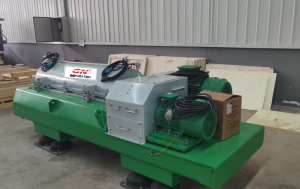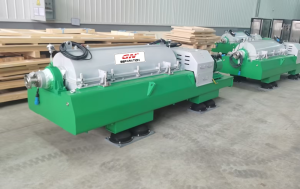Energy consumption is one of the largest expenses in operating a wastewater treatment plant. Whether it is municipal engineering, oil and gas exploration or mining, a large amount of waste and sewage in the project will be generated. Recycling and treatment these sewage can not only save a lot of costs but also reduce the impact on the environment and achieve long-term and stable development of the enterprise. And solid-liquids separation is one of the best solution for this challenge.
GN Dewatering Centrifuge- The Key Equipment For Sewage Treatment
GN Dewatering centrifuges play a vital role in water treatment processes, particularly for industries that deal with large volumes of solid-liquid mixtures. These centrifuges are designed to efficiently remove excess water from such mixtures, making them more manageable and reducing the overall volume of waste that needs to be disposed of.
In the case of overseas clients, their long-term project likely involves treating large amounts of wastewater or sludge generated from industrial processes. By investing in GN dewatering centrifuges, they are able to streamline their water treatment process, reduce operating costs, and potentially even recover valuable resources from the solid waste.

How does it work?
Feed Material: The mixture of water and solids, such as wastewater, sludge, or sediments, is fed into the centrifuge through GN Screw Pump. The mixture may be pre-treated to remove large particles or debris that could damage the centrifuge or interfere with the separation process.
Centrifugal Separation: Once inside the centrifuge, the mixture is exposed to a rapidly spinning drum. The drum rotates at high speeds, generating a strong centrifugal force that acts on the mixture. This force causes the heavier solid particles to be flung outward towards the walls of the drum, while the lighter water remains closer to the center of the drum.
Separation: As the mixture spins inside the drum, the differences in density between the water and solids cause them to separate. The lighter water forms a layer that is typically discharged through a port located near the center of the drum. This discharge layer may be further treated or recycled depending on the specific application.
Dewatering: The solid particles that accumulate at the outer rim of the drum undergo a process of dewatering. The centrifuge’s design, including the use of screens or perforated walls, allows for efficient removal of excess water from the solids. This process reduces the moisture content of the solids, making them easier to handle and dispose of.
Product Collection: The resulting dewatered solids are collected in a separate container or hopper located at the end of the centrifuge. Depending on the application, these solids may be further processed, incinerated, or disposed of in a landfill.

About Us
GN can not only provide users with Dewatering Decanter Centrifuges, rely on GN rich production line of separation and conveying equipment. GN can also provide users with turnkey solutions for the material dewatering process, including solutions for material transportation, classification and dewatering.